

History for Kids: Aztecs, Maya, and Inca. Back to History The three most dominant and advanced civilizations that developed in the Americas prior to the arrival of the Europeans were the Aztecs, the Maya, and the Inca.
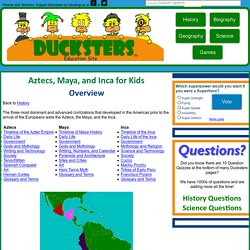
Map of Aztec, Mayan, and Incan Civilizations by Ducksters Aztecs The Aztec Empire was located in central Mexico. Maya numerals. Maya numerals Numbers above 19[edit] Numbers after 19 were written vertically in powers of twenty.
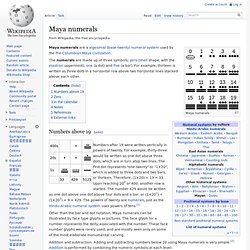
For example, thirty-three would be written as one dot above three dots, which are in turn atop two lines. The first dot represents "one twenty" or "1×20", which is added to three dots and two bars, or thirteen. Therefore, (1×20) + 13 = 33. Other than the bar and dot notation, Maya numerals can be illustrated by face type glyphs or pictures. Addition and subtraction: Adding and subtracting numbers below 20 using Maya numerals is very simple.[2]Addition is performed by combining the numeric symbols at each level: HISTORY OF THE MAYA. The Maya then and now: from 1500 BC The Maya, occupying the triangle of land framed by the Gulf of Mexico, the Caribbean Sea and the Pacific Ocean, have the longest identifiable history of any American people.
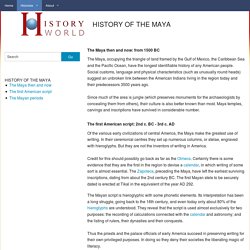
Social customs, language and physical characteristics (such as unusually round heads) suggest an unbroken link between the American Indians living in the region today and their predecessors 3500 years ago. Since much of the area is jungle (which preserves monuments for the archaeologists by concealing them from others), their culture is also better known than most. Maya temples, carvings and inscriptions have survived in considerable number. The first American script: 2nd c. Search the citations of other students: EasyBib: Free Bibliography Maker - MLA, APA, Chicago citation styles. Mayan hieroglyphic writing. Mayan hieroglyphic writing, system of writing used by the Maya people of Mesoamerica until about the end of the 17th century, 200 years after the Spanish conquest of Mexico.
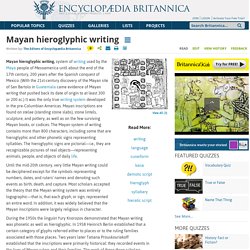
(With the 21st-century discovery of the Mayan site of San Bartolo in Guatemala came evidence of Mayan writing that pushed back its date of origin to at least 300 or 200 bc.) It was the only true writing system developed in the pre-Columbian Americas. Mayan inscriptions are found on stelae (standing stone slabs), stone lintels, sculpture, and pottery, as well as on the few surviving Mayan books, or codices. The Mayan system of writing contains more than 800 characters, including some that are hieroglyphic and other phonetic signs representing syllables. The hieroglyphic signs are pictorial—i.e., they are recognizable pictures of real objects—representing animals, people, and objects of daily life.
During the 1950s the linguist Yury Knorozov demonstrated that Mayan writing was phonetic as well as hieroglyphic. Unearthing the Mayan Creation Myth. Archaeologists who have uncovered two massive carved stucco panels in the Mirador Basin of Guatemala’s northern rain forest say they are the earliest known representation of the Mayan creation myth, predating other such artifacts by a millennium.
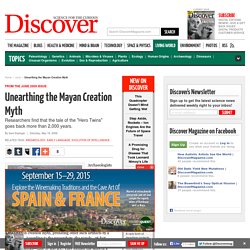
According to the researchers, the panels—26 feet long and 20 feet high, with images of monsters, gods, and swimming heroes—date to 300 B.C. They formed the sides of a channel that carried rainwater into a complex system of stepped pools, where it was stored for drinking and agriculture. History - Ancient History in depth: The Fall of the Mayan Civilisation. Mayan religion. Intense droughts blamed for Mayan collapse - 13 March 2003. Mayan Family. Mayan calendar. Climate Change Killed off Maya Civilization, Study Says. The drought theory is still controversial among some archeologists who believe a combination of overpopulation, an internecine struggle for control among the nobles, a weak economic base, and a political system that didn't foster power-sharing led to the Maya's collapse.

One hypothesis suggests the Maya people themselves were responsible for their downfall as a result of environmental degradation, including deforestation. Defenders of the climate change theory, however, say the droughts sparked a chain of events that led to the demise of the Maya. "Sunny days, in and of themselves, don't kill people," said Richardson B. Mayan Civilization City of Copan, Honduras. Copán, called Xukpi by its residents, rises out of the mist of western Honduras, in a pocket of alluvial soil amid rugged topography.
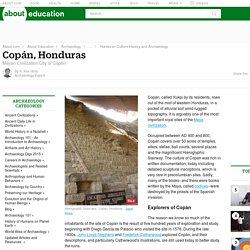
It is arguably one of the most important royal sites of the Maya civilization. Occupied between AD 400 and 800, Copán covers over 50 acres of temples, altars, stelae, ball courts, several plazas and the magnificent Hieroglyphic Stairway. The culture of Copán was rich in written documentation, today including detailed sculptural inscriptions, which is very rare in precolumbian sites. Mayan Numbers" Along with their calendars -- the Tzolk'in, the Haab and the Long Count -- the Mayans also created their own math system.
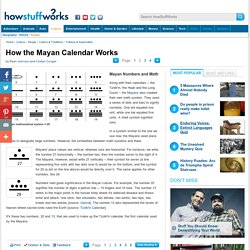
They used a series of dots and bars to signify numbers. One dot equaled one unit, while one bar equaled five units. A shell symbol signified zero. In a system similar to the one we use now, the Mayans used place values to designate large numbers. However, the similarities between math systems end there. Mayans' place values are vertical, whereas ours are horizontal. The Mayan Civilization Time Line. How the Mayan Calendar Works" Mayan mathematics. Version for printing Hernán Cortés, excited by stories of the lands which Columbus had recently discovered, sailed from Spain in 1505 landing in Hispaniola which is now Santo Domingo.

After farming there for some years he sailed with Velázquez to conquer Cuba in 1511. History - Ancient History in depth: The Fall of the Mayan Civilisation. Collapse: The Maya. The ancient Maya once occupied a vast geographic area in Central America.

Their civilization extended to parts of what is now Mexico, Honduras, and El Salvador, and most of Guatemala and Belize. From the third to the ninth century, Maya civilization produced awe-inspiring temples and pyramids, highly accurate calendars, mathematics and hieroglyphic writing, and a complex social and political order. Looking at the impressive remains of ancient Maya civilization, it's hard to imagine how such a society could collapse. Looking for clues at Copán Clues to this collapse can be found at Copán, a Maya site in western Honduras. The Rise and Fall of the Mayan Empire. The Rise and Fall of the Mayan Empire Scientists are using space satellites to unravel one of the great mysteries of the ancient world. Listen to this story via streaming audio, a downloadable file, or get help. November 15, 2004: Where the rain forests of Guatemala now stand, a great civilization once flourished. The people of Mayan society built vast cities, ornate temples, and towering pyramids.
At its peak around 900 A.D., the population numbered 500 people per square mile in rural areas, and more than 2,000 people per square mile in the cities -- comparable to modern Los Angeles County. This vibrant "Classic Period" of Mayan civilization thrived for six centuries. Right: Mayan ruins in Guatemala. The Mayan Calendar.
El Castillo. Chichen Itza, Yucatan, Mexico. This Mesoamerican step pyramid’s platform, along with its four stairways of 91 steps, totals 365, or the number of days in a calendar year. Aztec Calendar. The Aztec calendar was an adaptation of the Mayan calendar. It consisted of a 365-day agricultural calendar, as well as a 260-day sacred calendar. Mystery of the Maya - Maya civilization. The Maya are probably the best-known of the classical civilizations of Mesoamerica. Originating in the Yucatán around 2600 B.C., they rose to prominence around A.D. 250 in present-day southern Mexico, Guatemala, northern Belize and western Honduras. Building on the inherited inventions and ideas of earlier civilizations such as the Olmec, the Maya developed astronomy, calendrical systems and hieroglyphic writing.
The Maya were noted as well for elaborate and highly decorated ceremonial architecture, including temple-pyramids, palaces and observatories, all built without metal tools. They were also skilled farmers, clearing large sections of tropical rain forest and, where groundwater was scarce, building sizeable underground reservoirs for the storage of rainwater. The Maya were equally skilled as weavers and potters, and cleared routes through jungles and swamps to foster extensive trade networks with distant peoples. Backgrounders: Maya Civilization. Maya Civilization. Geography and Landscape. Ancient Mayans likely had fountains and toilets - Technology & science - Science - LiveScience. The ancient Mayans may have had enough engineering know-how to master running water, creating fountains and even toilets by controlling water pressure, scientists now suggest.
Maya.